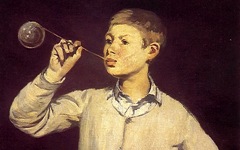Cézanne, Chardin, Mountain and Breast

L: Cézanne, Self-portrait in a White Cap (1881-2) Oil on canvas. Neue Pinakothek, Munich.
R: Chardin, Self-portrait Wearing an Eyeshade (1775) Pastel. Louvre, Paris.
Click image to enlarge.
In an important self-portrait Cézanne wears a white head-wrap as a known homage to the 18th-century French master Chardin and also, I believe, to the many artists before Chardin who wore turbans of cloth in the studio (and in their self-portraits) to keep paint off their hair.1 What has not been noticed, though, is that ......
Click next thumbnail to continue

L: Chardin, Self-portrait Wearing an Eyeshade (1775)
R: Cézanne, Mont Sainte-Victoire (1890) Musée d'Orsay, Paris
Click image to enlarge.
.......Chardin's headwear is similar to the shape of Mont Sainte-Victoire, the mountain Cézanne began to paint within a year of his self-portrait. Made famous by Cézanne, it is not just a major landmark of the artist's neighbourhood but a symbol of Cézanne's sense of identification with both the land and the earlier French master. It is a metamorphosis, the basis of all art, the likes of which Cézanne used to read about in his favorite lunch-time book while out painting, The Metamorphoses of Lucius Apuleius. He read it in Latin.
Click next thumbnail to continue

L: Cézanne, Mont Sainte-Victoire and the Chåteau Noir (1904-6) Oil on canvas. Bridgestone Museum of Art, Tokyo.
R: Chardin, Detail of Self-portrait with an Eyeshade
Click image to enlarge.
Gauguin revealingly wrote of Cézanne's familiarity with Latin literature: “Just like Virgil who has many meanings and who can be interpreted as one wishes, the literature of [Cézanne's] works has a metaphorical sense with two aims; its essence is as imaginative as it is realistic [my italics.]2
Cézanne often placed two separate but contiguous forms at the base of the mountain, curved or circular, like the dark shapes of trees to the right of the Chåteau (far left). They seem to represent eyes, either Chardin's or Cézanne's, or perhaps even Chardin's spectacles.3 Take a look at the next comparison.....
Click next thumbnail to continue

L: Cézanne, Mont Sainte-Victoire Seen from Bibemus (c.1897) Oil on canvas. Baltimore Museum of Art.
R: Chardin, Detail of Self-portrait with an Eyeshade
Click image to enlarge.
Cézanne mixed nature and art in all his landscapes so that the summit changes shape while still referring to Chardin's cap. For example, at left, he more than doubles the size of the mountain. Furthermore the color of Chardin's face is echoed in the rocks with the white and gray of his wrap reflects the mountain.4 With the background a shade of green and touches of blue in the fabric, the source and metamorphosis share the same palette: ochre, light blue, green and white.
Click next thumbnail to continue

Top: Cézanne, Mont Sainte-Victoire with detail rotated 90*, c.1902
Bottom: Landscape at Aix (Mont Sainte-Victoire) 1905 Oil on canvas. The Pushkin Museum of Fine Art, Moscow.
Click image to enlarge.
After 1900 the mountain in Cézanne's landscapes takes on the form of a female breast (see top image rotated 90*). The breast-shaped mountain is an archetype, mankind's creative source and Cézanne's too, the Great Mother of his mind.5 She also symbolizes his androgynous nature which he felt so strongly about that he painted a female breast on an actual self-portrait as we revealed in Cézanne's Self-portrait with a Beret.
See conclusion below
Just as we have shown that the earliest-surviving landscape drawing, Leonardo's Landscape Study , is not natural because it includes the transformation of a face and Goya's The Meadows of San Isidro is based on a closed eye, so here the mountain as symbol for the creative mind takes on the form of Chardin's headwear or a breast. The so-called "eyes" that we see in Cézanne's landscape will not convince everyone on their own but try to remember them when we look at other landscapes, especially those by Leonardo and Raphael. You'll be surprised.
More Works by Cezanne, Chardin
Learn how to look at Cézanne differently, using another form of visual perception

Cézanne’s Bathers (1899-1904)
Notes:
1. Cézanne (Philadelphia Museum of Art) 1996, p.232; The supposed self-portrait of Jan van Eyck in the National Gallery, London, wears a turban; Michael Wolmegut wears a turban in his portrait by Durer; and La Fornarina, whom we have shown here is a self-representation of Raphael, wears a turban too. Hyacinthe Rigaud also wears a turban in a self-portrait
2. Nina Maria Athanassoglou-Kallymer, Cézanne and Provence: The Painter in His Culture (University of Chicago Press) 2003, p.187
3. The presence of eyes resembling something else has been shown here in work by Leonardo, Titian, Giovanni Bellini, Parmigianino as well as by Goya, Egon Schiele and Picasso.
4. A compositional analysis between the actual scene in a photograph and the painting indicates that half the right cliff-face disappears into deep shade which Cézanne seems to have ignored to suggest the two halves of a face. Erle Loran, Cézanne's Compositions: Analysis of his Form with Diagrams and Photographs of His Motifs (University of California Press) 1963, pp. 60-65
5. Erich Neumann, The Great Mother: An Analysis of the Archetype [1955], 2nd. ed., trans. R. Manheim (Princeton University Press) 1963, pp. 98-99.
Original Publication Date on EPPH: 08 May 2011. | Updated: 0. © Simon Abrahams. Articles on this site are the copyright of Simon Abrahams. To use copyrighted material in print or other media for purposes beyond 'fair use', you must obtain permission from the copyright owner. Websites may link to this page without permission (please do) but may not reproduce the material on their own site without crediting Simon Abrahams and EPPH.


